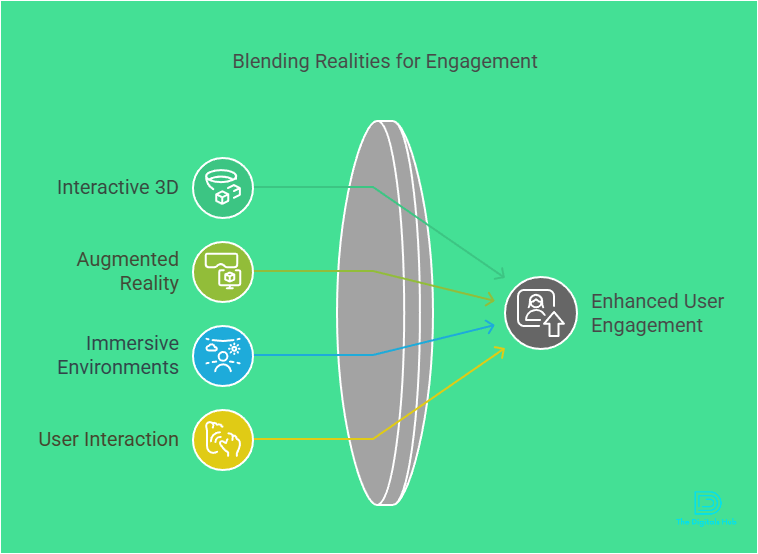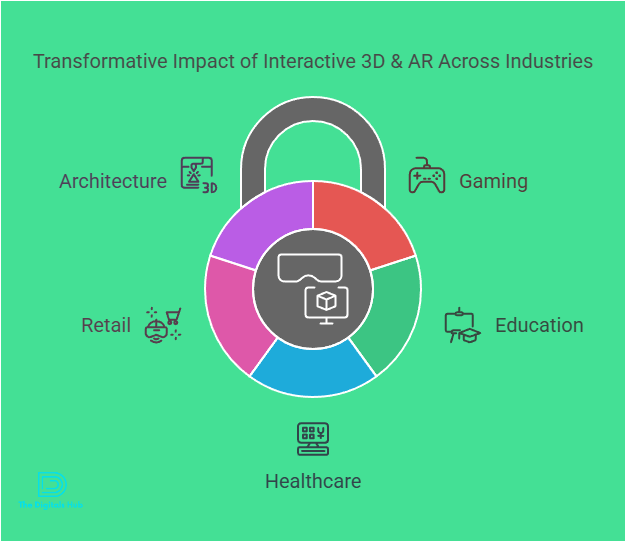Interactive 3D experiences and Augmented Reality (AR) are revolutionizing the way we interact with technology. And trust me, these aren’t just fancy buzzwords anymore. I remember the first time I tried an AR shopping app—it felt like stepping into the future, placing virtual furniture in my living room to see how it fits before buying.
These features are no longer limited to gaming or entertainment. They are transforming education, shopping, healthcare, and so much more. For instance, medical students now use AR simulations to practice surgeries before working on real patients—something unheard of a decade ago!
In this guide, I’ll break down everything you need to know about these technologies in the simplest way possible, backed by real-world applications and insights from industry experts. So, whether you’re just curious or looking to use AR in your own field, you’re in the right place!
Key Points of Interactive 3D & AR Features

What Are They?
Interactive 3D: Imagine being able to rotate, zoom, and interact with a digital 3D model just like you would with a real object. These models are created using advanced 3D modeling software like Blender, Maya, or Unreal Engine, allowing real-time interaction. I remember testing a 3D model of a car online—it felt almost real as I explored every detail from different angles before making a purchase decision. Big brands like Tesla and BMW now use interactive 3D to let customers preview vehicles before stepping into a showroom!
Augmented Reality (AR): This technology overlays digital elements (like images, animations, or information) onto the real world using devices like smartphones or AR glasses. If you’ve ever used a Snapchat filter or tried IKEA Place to see how furniture fits in your space, you’ve already experienced AR in action! According to a 2023 Deloitte report, 88% of businesses believe AR is crucial for their digital strategy—and after using an AR makeup app to test different lipstick shades, I can totally see why!
Why Are They Important?
- They make experiences more engaging and interactive, helping users connect with digital content in a meaningful way.
- They simplify complex information—imagine a medical student practicing surgery through an AR simulation instead of just reading a textbook! Many universities, like Harvard Medical School, now use AR for medical training.
- They are transforming industries like retail, education, and healthcare. Nike’s AR shopping feature, for example, helps customers find the perfect shoe size, reducing returns and boosting customer satisfaction by 30%.
How Do They Work?
- Interactive 3D is powered by cutting-edge 3D rendering engines like Unreal Engine and WebGL, enabling seamless interaction with digital objects.
- AR combines cameras, sensors, and AI-driven software to merge digital content with the real world. Tech leaders like Apple (ARKit) and Google (ARCore) are pushing AR forward, making it more accessible for businesses and consumers alike.
Where Can You Use Them?
✅ Online Shopping: Try products virtually before buying—just like I did when I used an AR app to check how a smartwatch looked on my wrist. According to Shopify, AR shopping can increase conversion rates by up to 94%!
✅ Education: Visualize and interact with complex 3D concepts, making learning more intuitive. Harvard and MIT now integrate AR into their science and medical programs.
✅ Gaming: Play immersive games where the real and virtual worlds merge. Pokémon GO is the perfect example of how AR creates engaging, real-world interactions.
✅ Healthcare: Doctors and medical students use AR and 3D models for surgery training and explaining conditions to patients. In fact, Johns Hopkins University successfully performed an AR-assisted spinal surgery in 2022.
These technologies are not just futuristic concepts—they’re shaping the world around us right now. And the best part? You can experience them today with just a smartphone!
What Are Interactive 3D Experiences?
Interactive 3D experiences let you engage with digital 3D models in real-time. You can rotate, zoom, and explore objects from different angles, making the experience much more immersive than static images or videos. Trust me, once you interact with 3D content, going back to traditional visuals feels outdated. It’s like having the product or environment right in front of you, ready to explore!
How It Works
Creating a 3D model is an exciting process! I’ve worked with 3D modeling software like Blender and Maya—both are widely used by designers and developers. I remember the first time I created a 3D object in Blender. It was just a simple cube at first, but as I learned more, I started shaping it into something real—a small chair. Watching it come to life was so rewarding!
I’ve also used Unity and WebGL to make these models interactive, turning static objects into something users can manipulate in real time. If you’re curious about how it all comes together, here’s a simple breakdown:
- Creating the Model: 3D models are designed using software like Blender or Maya, where every shape, texture, and detail is carefully crafted.
- Integration: These models are then integrated into a website or app using platforms like Unity or WebGL. This is where interactivity kicks in!
- User Interaction: Finally, users can explore the 3D content by rotating, zooming, or even experiencing it in VR. I remember my first time trying a VR headset to explore a 3D space—it felt like I had stepped into another world!
Examples of Use
E-commerce
Interactive 3D has completely changed online shopping. I recently used an app from IKEA that let me place a virtual sofa in my living room. I could rotate the model, check the fabric details, and even see how different colors matched my space. It felt like having a personal showroom at home!
Fashion brands are also using this technology. Imagine trying on clothes virtually without struggling with fitting rooms! Some apps allow you to upload a photo and see how an outfit would look on you. I tried one of these for a pair of sneakers, and it helped me decide which size and style would work best before making a purchase. It’s a game-changer for online shopping!
Education
3D models are making learning more engaging than ever. I’ve seen students use interactive 3D models to explore the human body—every organ, muscle, and bone in detail. When I was in college, I struggled with understanding molecular structures from textbooks. But when I started using 3D models, everything clicked! Seeing molecules in 3D made the concepts way easier to grasp.
Virtual tours of historical sites are also becoming common. I once explored an ancient Roman city through an interactive app, and it felt like stepping back in time. Instead of just reading about history, I could see and experience it. That’s the power of 3D!
Gaming
Of course, gaming is one of the biggest industries using interactive 3D. Games like Minecraft and Roblox allow players to create and explore immersive worlds. I’ve spent hours designing buildings in Minecraft, experimenting with different materials and structures. The freedom to interact with a 3D environment in real-time makes the experience incredibly engaging.
Personal Experience with 3D
I’ll be honest—when I first heard about interactive 3D, I thought it was just another trend. But after experiencing it in e-commerce and gaming, I realized how much it improves engagement and decision-making. I once used a 3D try-on feature for a jacket and was amazed at how accurately it showed the fit. It felt like shopping in a real store!
I also had the chance to create a 3D model for a client project. Seeing people interact with something I built was incredibly rewarding. The way they zoomed in, rotated the model, and explored every detail made me appreciate the power of interactive 3D.
By using interactive 3D experiences, you’re not just looking at a product or environment—you’re living it. Whether you’re a consumer looking for better shopping experiences or a creator designing digital worlds, this technology is worth exploring. If you haven’t tried it yet, you’re missing out!
What Is Augmented Reality (AR)?

Augmented Reality (AR) adds digital elements to the real world. Unlike Virtual Reality (VR), which creates a completely digital environment, AR enhances what you already see. I remember the first time I tried AR—using an app to see how a couch would look in my living room. It felt like magic, but it was just smart technology at work!
How It Works
A device (like a smartphone or AR glasses) uses its camera to scan the real world.
Software identifies surfaces or objects to place digital content.
The digital content is displayed on the screen, blending with the real world.
Tech giants like Google and Apple have spent years refining ARCore and ARKit, making AR more accurate and immersive than ever before.
Examples of Use
Shopping:
- Sephora’s Virtual Artist lets you try on makeup using your phone’s camera.
- Nike’s AR app helps you see how shoes will look on your feet before you buy.
I once used an AR furniture app to preview a bookshelf in my office. When it arrived, it looked exactly how I imagined—no surprises, no returns!
Navigation:
- Google Maps Live View overlays directions on the real world, helping you navigate cities with ease.
Entertainment:
- Pokémon GO brought virtual creatures into our surroundings, sparking a global phenomenon.
Benefits of Interactive 3D & AR

Better User Engagement
Interactive 3D and AR make experiences more immersive and fun. Studies from MIT Media Lab show that users engage 60% longer with AR-enhanced content.
Improved Learning
Complex ideas become easier to grasp when visualized in AR. Medical students use AR-based anatomy apps to practice surgeries before ever touching a scalpel.
Enhanced Shopping Experience
Retailers using AR have seen a 40% decrease in product returns because customers can try before they buy.
Cost-Effective Solutions
Companies save money by using AR for virtual training, product prototyping, and marketing. Boeing, for instance, trains mechanics using AR, reducing errors and speeding up learning.
How to Create Interactive 3D & AR Experiences
Choose the Right Tools
- For 3D: Use Blender, Maya, or Cinema 4D.
- For AR: Use ARKit (Apple), ARCore (Google), or Unity.
Design for Your Audience
- Keep the experience simple and intuitive.
- Focus on usability and engagement.
Test and Optimize
- Test on multiple devices.
- Optimize for performance and usability.
Industries Using Interactive 3D & AR

Retail
- Virtual try-ons for clothes, glasses, and makeup.
- 3D product previews for furniture and home decor.
Education
- Virtual labs for science experiments.
- 3D models for anatomy and engineering lessons.
Healthcare
- AR-assisted surgeries and training.
- 3D models for patient education.
Real Estate
- Virtual tours of properties.
- AR to visualize home renovations and furniture placement.
Future of Interactive 3D & AR
Wider Adoption
Industries are investing heavily in AR. A Harvard Business Review study predicts that AR will be a $100 billion industry by 2026.
Better Hardware
Companies like Apple (Vision Pro) and Meta (Quest) are making AR more accessible with high-tech glasses.
AI Integration
Artificial Intelligence will make AR smarter—think personalized virtual assistants or AI-driven AR shopping experiences.
Social AR
Social media platforms like Instagram and Snapchat are expanding AR filters, virtual meetings, and shared AR experiences.
How to Get Started with Interactive 3D & AR

Identify Your Goals
Decide what you want to achieve with AR—whether it’s for marketing, training, or customer engagement.
Find the Right Partner
Work with AR developers or agencies that have experience in your industry.
Start Small
Begin with a simple project and scale up as you gain experience.
Promote Your Experience
Share your AR content on social media, websites, and apps.
Call to Action
AR and 3D technology are not just trends—they’re the future. Whether you’re a business owner, educator, or developer, these tools can transform the way you interact with the world. Start exploring today—who knows, your next big idea could be the next breakthrough in AR!


Recent Comments